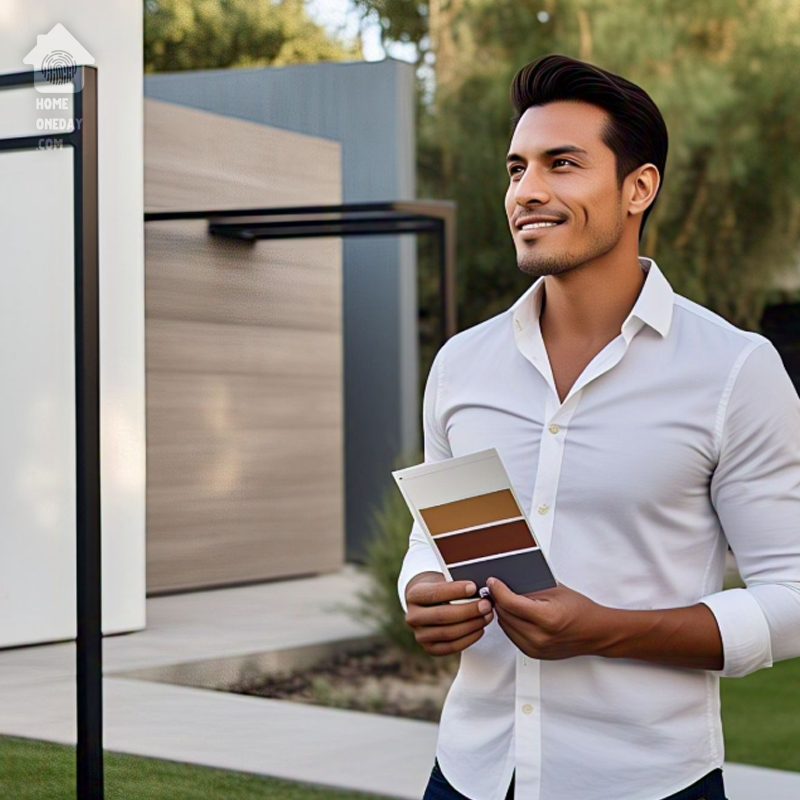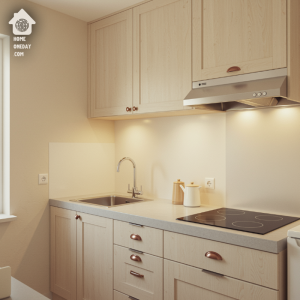Embarking on home improvement projects, whether it’s crafting a serene deck or building a cozy window seat, is a common endeavor for homeowners. While many succeed, some find themselves overwhelmed. The key to a successful project lies in preparation and knowledge. This article will provide expert home improvement advice to ensure success. Let’s dive in!
Home Improvement Advice: Choosing the Right Paint for Your Home

Choosing the right paint is crucial, especially for exterior projects like porches. Opt for a high-quality exterior paint that is durable and weather-resistant. When selecting paint, ensure it matches the base of the previous paint used to maintain consistency and prevent adhesion issues. Oil-based paints, known for their longevity, are excellent for trim. However, it’s essential to avoid using oil-based paint on surfaces that are walked on, such as steps or decks, as they become slippery when wet, posing a safety hazard.
No-Nonsense Advice and Ideas for Home Improvement Projects provides additional insights into making smart home improvement choices.
Why Matching Paint Bases Matters
Matching the paint base is a simple yet vital detail often overlooked. Using a different base can lead to poor adhesion, resulting in peeling and cracking paint. This not only diminishes the aesthetic appeal of your home but also requires more frequent repainting, costing you time and money.
The article Easy Home Improvement Tips: Upgrade Your Space Affordably explores more ways to enhance your home with cost-effective upgrades.
Expert Home Improvement Advice: Is Oil-Based Paint the Right Choice?
Oil-based paints offer exceptional durability, making them an ideal choice for trim and areas prone to wear and tear. They create a hard, protective layer that resists scratches and scuffs, ensuring your paint job lasts longer. However, their slipperiness when wet makes them unsuitable for walking surfaces. Selecting the right paint type and ensuring it is applied correctly is critical for both aesthetics and safety. So, consider where the paint will be placed before deciding.
Aging Wall Paneling Before Installation
When working with new wall paneling, it is wise to age the panels for a few days before installing them. Freshly delivered paneling is often stored in tightly packed piles at the warehouse, leading to compression. Upon removal and exposure to normal room humidity, the individual pieces may shrink. By allowing the paneling to acclimate to your home’s environment for a few days, you prevent potential issues caused by shrinkage, such as gaps and uneven surfaces.
For more expert advice, Practical Tips to Help Improve Your Home covers essential preparation steps for a smooth home improvement process.
The Science Behind Paneling Shrinkage
Paneling shrinkage occurs due to changes in moisture content. When wood absorbs or loses moisture, it expands or contracts accordingly. Newly manufactured paneling typically has a higher moisture content. As it dries out in your home, it shrinks. By aging the paneling, you allow it to reach equilibrium with your home’s humidity levels, minimizing shrinkage after installation. This simple step can save you from costly repairs and ensure a professional-looking finish. The best way to think about this is to consider how wood adapts to its environment.
Practical Tips for Aging Paneling

To properly age your wall paneling, simply unstack the panels and lay them flat in the room where they will be installed. Ensure there is adequate air circulation around each panel to facilitate even drying. Allow the panels to sit for at least three to five days, depending on the humidity levels in your home. This waiting period may seem like a minor inconvenience, but it significantly contributes to the long-term stability and appearance of your finished walls. Think of it as an investment in the longevity and quality of your paneling project.
Energy-Saving Home Improvement Advice: Are CFL Bulbs Worth It?
When considering home improvements, evaluating the cost-effectiveness of CFL bulbs is essential. While CFL bulbs are energy-efficient, using less wattage and lowering electricity bills, their initial cost is higher than traditional incandescent bulbs. Additionally, CFL bulbs contain mercury, which poses a health hazard if broken. Weigh the energy savings against the upfront cost and potential environmental concerns to make an informed decision about switching to CFL bulbs.
The comparison between CFL and LED bulbs is discussed further in Easy Home Improvement Tips: Upgrade Your Space Affordably to help you decide on the best lighting solutions for your home.
Comparing CFL and LED Bulbs
In recent years, LED bulbs have emerged as an alternative to CFLs, offering even greater energy efficiency and longer lifespans. While LED bulbs may have a higher upfront cost than CFLs, they consume less energy and do not contain mercury. Comparing the long-term costs and environmental impact of CFLs and LEDs can help you choose the most sustainable and cost-effective lighting solution for your home. It’s like comparing a fuel-efficient car to an electric one; both save money, but one offers additional environmental benefits.
Addressing Safety Concerns with CFL Bulbs
The presence of mercury in CFL bulbs raises concerns about potential health risks if the bulb breaks. Mercury is a neurotoxin that can be harmful if inhaled or ingested. If a CFL bulb breaks, it is essential to follow proper cleanup procedures, such as ventilating the room, carefully collecting the broken pieces, and disposing of them at a designated recycling center. Being aware of these safety precautions can help you minimize the risks associated with CFL bulbs. Think of it as handling any potentially hazardous material; caution and proper procedures are key.
Home Improvement with Resale in Mind
If you are planning to sell your house soon, tailor your home improvement projects to maximize its resale value. Focus on critical maintenance items and areas with high visibility, such as the kitchen, bathrooms, and curb appeal. Avoid making highly personalized or unconventional design choices that may not appeal to a broad range of potential buyers. If you are not planning to sell soon, you have more freedom to design according to your personal tastes and preferences. Will your home improvements enhance resale value?
Prioritizing Key Maintenance Items
When preparing your home for sale, prioritize essential maintenance tasks, such as repairing leaky roofs, fixing plumbing issues, and addressing electrical problems. These issues can deter potential buyers and significantly lower your home’s value. By tackling these critical repairs, you demonstrate that your home is well-maintained and ready for a new owner. Think of it as giving your car a tune-up before selling it; it shows that you care about its condition and ensures it runs smoothly for the next owner.
Easy Home Improvement Advice: Boost Your Home’s Curb Appeal
Curb appeal is the first impression potential buyers have of your home, so it’s crucial to make it inviting and attractive. Simple improvements like landscaping, painting the front door, and adding new hardware can significantly enhance your home’s exterior. A well-maintained lawn, colorful flowers, and a clean walkway create a welcoming atmosphere that draws buyers in. It’s like dressing up for a job interview; you want to present yourself in the best possible light to make a positive impression.
DIY Home Improvement Advice: Expert Tips to Restore Your Tiles with Vinegar

Embarking on home improvement projects? Get the best home improvement advice to ensure success. Over time, tiles can become dull and faded due to accumulated dirt and grime. A simple and effective solution is to mix vinegar and water to clean your tiles without causing damage. The acidic properties of vinegar help to dissolve dirt and restore the shine to your tiles. This natural cleaning solution is both environmentally friendly and cost effective. A simple mixture can make your floors look new again!
The Science Behind Vinegar’s Cleaning Power
Vinegar’s cleaning prowess lies in its acetic acid content, which effectively breaks down mineral deposits, grease, and grime. Unlike harsh chemical cleaners, vinegar is a mild acid that won’t damage most tile surfaces. It’s a natural and safe alternative to commercial cleaning products. It’s like using lemon juice to clean a cutting board; the acidity naturally disinfects and removes stains without harsh chemicals.
Step-by-Step Guide to Cleaning Tiles with Vinegar
To clean your tiles with vinegar, mix equal parts of white vinegar and water in a bucket. Mop the floor with the solution, ensuring to cover all tiled surfaces. For stubborn stains, allow the solution to sit for a few minutes before scrubbing with a soft brush or sponge. Rinse the floor with clean water to remove any vinegar residue. This simple process will leave your tiles sparkling and refreshed. Think of it as a spa day for your floors; a little pampering can make a big difference.
Conclusion
Taking on home improvement projects can be both exciting and challenging. By following these tips, you can approach your projects with confidence and achieve successful results. Whether it’s choosing the right paint, preparing wall paneling, or cleaning tiles, remember that preparation and knowledge are key to a job well done. Happy improving!
FAQs
1. How do I choose the right paint finish for my walls?
The right paint finish depends on the room and its use. Matte finishes are great for low-traffic areas and hiding imperfections, while satin or eggshell finishes are more durable and easier to clean, making them suitable for kitchens and bathrooms.
2. How long should I age wall paneling before installation?
Ideally, you should age wall paneling for at least three to five days to allow it to acclimate to your home’s humidity levels. This helps prevent shrinkage and ensures a seamless installation.
3. Are LED bulbs a better option than CFL bulbs for energy efficiency?
Yes, LED bulbs are generally more energy efficient than CFL bulbs. They consume less energy, have a longer lifespan, and do not contain mercury, making them a more sustainable choice.
4. What are some budget-friendly ways to improve my home’s curb appeal?
Simple and affordable ways to enhance curb appeal include landscaping, painting the front door, adding new hardware, and ensuring your lawn is well-maintained.
5. Can I use vinegar to clean all types of tiles?
Vinegar is safe for most types of tiles, including ceramic, porcelain, and glass. However, avoid using vinegar on natural stone tiles like marble or granite, as the acid can damage the surface.
Remember, every project, big or small, is a step towards creating the home of your dreams. Don’t be afraid to start, learn along the way, and celebrate your accomplishments. Your home is a reflection of you, so let your creativity shine and make it a space you truly love. Believe in your abilities, stay positive, and keep moving forward!




